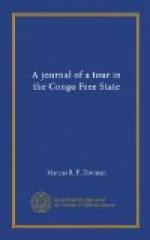One night I was awakened and saw the boys dancing excitedly about the fire and in front of my tent. Having asked the matter, Chikaia, whose zoological knowledge is very limited, replied il est la petite bete. This sounded like mosquitoes so, having tucked in my net more closely, I turned round to sleep. A few minutes afterwards, Lord Mountmorres appeared shouting with pain and mounting a chair in front of my tent rapidly peeled off his clothes. He said his bed was full of great black ants which had fixed on his skin and were biting him all over. Millions of these pests indeed were on the camping ground but had as yet not reached my tent. Hastily pulling on high boots and covering myself from head to foot, I cautiously crept out of the tent and found the ground black with ants. It was impossible to kill them by stamping about for they were simply driven into the soft sand and wriggled out again the moment the foot was withdrawn. We were evidently in the line of march of a migrating host and were forced to beat a hasty retreat leaving the insects in full possession.
There is no drinking water at Songo, so we had to boil and filter that from the river. This proved very difficult, for even after allowing it to settle and then carefully decanting it, there was so much mud left, that the pores of the porcelain candles in the filters frequently became blocked. We had therefore to be content with muddy water well boiled. As we had a fair amount of baggage, we required sixty or seventy paddlers and it was not easy to find so many. At length however, after searching on both sides of the river, crews were collected for three large canoes and we arranged to continue our journey on September 14th.
The canoes were lifted up the Songo rapids empty, while the baggage was carried along the bank. It was then stowed in the boats and having taken our places we made a start. The method of propulsion is very interesting to watch. The canoes are sixty or seventy feet long and three or four wide. In the centre is an awning to shade the white man and in front by the bows, a space is left about ten feet long in which three pole men work. These use their poles as in punting, except that the ends are forked, so that they are enabled to push either against the bottom of the river or rocks, or branches of trees on the bank, for the canoe keeps close to the shore all the time in order to give the polemen an opportunity and also to avoid the swifter current running in the centre of the river. In the stern twenty or thirty paddlers sit on the sides of the boat and work together, while on the extreme end two or three stand up with long paddles to steer. The cook with his fire built on a heap of clay in the bottom of the canoe, sits among the paddlers and the sentries and baggage tuck themselves in somewhere, for it is wonderful how many people and how much baggage these canoes will carry.




